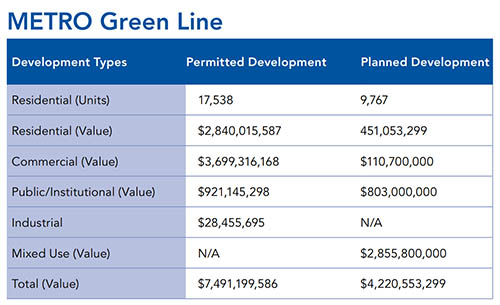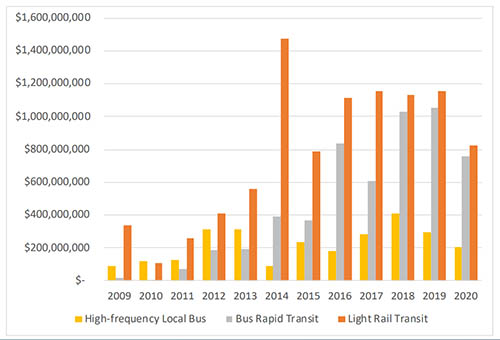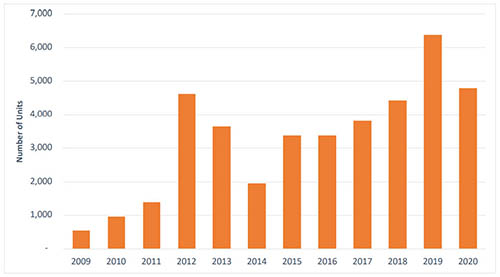METRO Green Line has region’s highest share of investments
A notable share of the seven-county metro area’s permitted and planned development continues to be located within a 10-minute walk of transit corridors that offer high-frequency service, including the METRO Green Line, which tallies nearly $12 billion in permitted and planned development.
This, and other details, are captured in the annual report from Metro Transit’s Office of Transit-Oriented Development. The report reveals that $15 billion in development was permitted along high-frequency transit between 2003 and 2020, and another $9.5 billion of development is planned in these corridors.
Of all the region’s transit corridors, the METRO Green Line has seen the highest level of permitted and planned development. The total value of permitted development since 2003 for commercial, public, and industrial development combined is more than $4.6 billion. Add the multifamily residential permitted value since 2009, and it totals nearly $7.5 billion. The corridor has an additional $4.2 billion of planned development.

Developers validate attraction of high-frequency transit
“We are strong believers in the ability of light rail transit to encourage investment both in the urban core and in suburban locations,” said Steve Wellington, CEO of Wellington Management. “We completed our fourth Green Line housing development in 2021. We also have developed four housing projects on the Blue Line and two more are underway on the Green Line Extension.
“These 10 projects in Minneapolis, Saint Paul and Minnetonka total 1,313 units and represent an investment of over $350 million,” Wellington said. “Four of these projects (428 units) are 100% affordable. We also own and manage two office buildings and three retail shopping centers on light rail.”
Construction of the METRO Green Line Extension, from Target Field southwest to Eden Prairie, is about 60% complete. To date, the corridor has seen $1.7 billion in permitted development and another $656 million currently planned.

METRO Gold Line, not yet under construction, sees new development
The METRO Gold Line is a planned 10-mile bus rapid transit line that will connect Saint Paul, Maplewood, Landfall, Oakdale, and Woodbury. The Gold Line will be the first bus rapid transit line in the state to operate primarily within bus-only lanes, primarily in the Interstate 94 corridor. Construction is expected to start this year.
Since the line entered the project development phase of the federal New Starts program in January 2018, there has been more than $388 million in permitted development within a half mile of the route and an additional $1.2 billion in development is planned.
Read about an affordable housing development for people with disabilities along the Gold Line.
41% of region’s multifamily development occurred along high-frequency transit
The report reveals that between 2003 and 2020, $15 billion in development was permitted along high-frequency transit, including:
- 41% of the region’s multifamily development by permit value
- 39,200 multifamily units – 61% of these units are near light rail, 40% are near bus rapid transit, and 30% are served by high-frequency local bus routes
- 39% of the region’s commercial development
- 28% of the region’s public and institutional development
- 7% of the region’s industrial development
An additional $9.5 billion of development is planned along high-frequency transit, representing 67% of the currently planned development for the region. This new development will add another 35,200 multifamily units, close to doubling the number of residences with immediate access to high-frequency transit.

Transportation connections and efficient land use are key to economic vitality
“This region’s economic vitality depends in part on the quality of our transportation connections and how efficiently we use land,” said Charlie Zelle, Metropolitan Council Chair. “Robust high-frequency transit and transit-oriented development tie together affordable housing, jobs, shopping, and other key destinations, reducing transportation and housing costs to create more equitable choices for residents.”
“As the region grows, infill development along high-frequency transit makes the most of existing infrastructure and community investments, and supports walkable, sustainable communities,” he added. “Even our transitways not yet in operation are seeing billions of dollars of investments in nearby housing and jobs.”
Pandemic impacted pace of development
Preliminary analysis of permit data and of local construction data indicate that the region experienced a drop in development activity due to the COVID-19 pandemic. However, early results suggest that development has been recovering relatively quickly, with construction activity increasing in 2021 both in the region generally and in areas served by high-frequency transit. In particular, multifamily residential development near high-frequency transit has continued to make up a significant share of construction in 2020-2021.
The 2021 Development Trends along Transit report used data from the Metropolitan Council’s Annual Building Permit Survey. It explores trends in multifamily residential development since 2009, as well as commercial, public and institutional, and industrial development since 2003. High-frequency transit includes both light rail and bus rapid transit, which make up the METRO transitway network, but also local bus routes that operate at least every 15 minutes.
Development Trends Along Transit – 2021 Report (PDF)